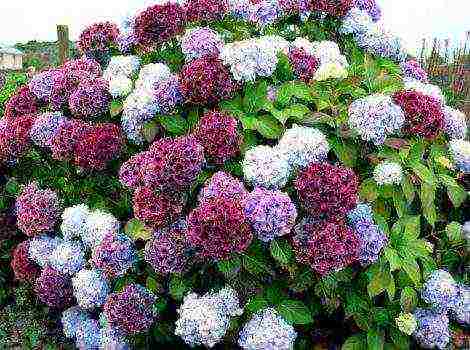Content
The period of active growth of hyacinths is about 3.5 months (April-July). In the Moscow region, hyacinths bloom from early to mid-May.
In the Moscow region, hyacinth bulbs are planted in the second half of September - early October. You need to choose a place for planting that is sunny, not flooded by spring waters. Areas with a close groundwater table are unsuitable. Permeable soils with a high humus content are preferred, but fresh and weakly decomposed manure is unacceptable. If the soil on the site is dense (clayey), river sand and neutralized peat are added to it, acidic soils are undesirable. For hyacinths, deep soil cultivation is needed - up to 40 cm.
 The planting site should be prepared already in August, otherwise the natural sediment of the loosened earth can cause the breakage of the roots, which begin to develop in the fall. For digging, in addition to humus, sand and peat, mineral fertilizers are applied - 60-80 g of superphosphate, 30 g of potassium sulfate or potassium salt and 15 g of magnesium sulfate per 1 m². Potassium sulfate can be replaced with wood ash - 200 g, and magnesium sulfate - with dolomite flour - up to 250 g per 1 m².
The planting site should be prepared already in August, otherwise the natural sediment of the loosened earth can cause the breakage of the roots, which begin to develop in the fall. For digging, in addition to humus, sand and peat, mineral fertilizers are applied - 60-80 g of superphosphate, 30 g of potassium sulfate or potassium salt and 15 g of magnesium sulfate per 1 m². Potassium sulfate can be replaced with wood ash - 200 g, and magnesium sulfate - with dolomite flour - up to 250 g per 1 m².
On soils with a high sand content, the doses of potash and magnesium fertilizers are increased by one and a half times. It is better to apply nitrogen fertilizers in the form of top dressing in the spring-summer period. The feeding area for an adult bulb (about 5 cm in diameter) is 200-250 cm², the planting depth from the bottom of the bulb is 15-18 cm. Small bulbs and children are planted denser and not so deep. When planting under the bottom of the bulb, it is advisable to add a small layer of sand. If the ground is dry, watering is needed. With the onset of cold weather, plantings should be well covered with a layer of leaves or peat. But in the spring, as soon as the soil begins to thaw, the shelter must be removed. Hyacinth sprouts appear very early.
As with all plants with a short growing season, all processes of spring-summer growth in hyacinths are very intensive, so at this time the plants must be provided with the necessary amount of nutrients and water. Immediately after removing the insulating shelter, the soil is loosened. This must be done very carefully so as not to damage the sprouts. Simultaneously with loosening, the first feeding is also given. For 1 m² you need 20-30 g of potassium nitrate or 50 g of nitrophoska, dissolved in 10 liters of water.
The second top dressing is full mineral fertilizer (NPK) at a dose of 60–70 g per 1 m² when buds appear. It can be repeated before flowering. And the latter - already without nitrogen or with a very small amount of it, immediately after the end of flowering (40 g per 1 m² of phosphorus and potassium fertilizers). Feeding with organic matter in the intervals between mineral fertilizing will not be superfluous. With a good filling of the soil with fertilizers, in the fall, hyacinths will bloom without additional fertilizing, but the bulb will consume nutrients instead of accumulating, which will affect flowering next year.
By about mid-July, the foliage of hyacinths begins to turn yellow and lie down. Then it's time to dig up the bulbs. Now a very important process of inflorescence formation will begin in them, for which a temperature of 23-25 ° is required. The bulbs dug out, dried and peeled from the remnants of leaves and roots are placed for 2 months somewhere in the house - on a cabinet or top shelf, and so that they do not dry out, a tray or bowl of water is placed next to it.
Annual digging is, of course, troublesome, but this makes it possible, in addition to warming up, to inspect the bulbs, reject the sick, treat them with chemicals in order to protect them from pests and diseases, separate large children for growing. During storage, the bulbs are periodically examined, destroying the sick.Small spots on the surface of the scales or on the bottom are cut out with a sharp knife and sprinkled with a mixture of sulfur and crushed coal. These bulbs are best stored separately. After each operation, the knife is disinfected.
Natural reproduction of hyacinths is slow. For a year, an adult bulb forms 1-2, less often 3-4 children, which need to be grown for another 2-3 years. Well-formed babies that are easily detached from the mother's bulb are grown separately. If they do not separate well, then it is better to plant the whole family so as not to injure the plant. Often during storage, many small children with a diameter of up to 5 mm are formed around the bottom. They are very fragile and break off easily. The bulb, together with the children, is especially carefully planted in the ground, halving the planting depth and increasing the cover layer.
Such a rapid formation of small children can be caused artificially, it is only necessary immediately after digging to wipe the bottom of the bulb with a dry cloth, removing the still juicy roots. Such babies need to be raised for 4-5 years. Specialized floriculture farms and experienced amateurs use special techniques for forced reproduction of hyacinths. These techniques are described in detail in special literature and can be mastered by any gardener.
Translated from Greek, hyacinth means "Rain Flower". Belongs to the genus of asparagus, the lily family. Like tulips and lilies, the hyacinth forms a bulb in the ground. Elongated leaves emerge from it in the spring, located in a rosette near the ground. Later, a peduncle appears from the middle, on which is an inflorescence-brush with bright flowers that have a bell-shaped shape. When the plants stop flowering, the stem and leaves die off. Small "babies" are formed on the bulb.

Grow wild in Mediterranean and South Asian countries. The first cultivar was developed in Holland. All other hyacinths that grow in our gardens originated from it. Now different varieties have been bred. Inflorescences are of various colors: purple, pink, white, red. Colors are bright, rich or delicate.
Growing methods in the Moscow region
In central Russia, hyacinths are grown in gardens, using bulbs for forcing leaves and flowers in greenhouses and at home. The difficulty of growing in the middle lane is weak winter hardiness. The following methods are used for breeding:
- With the help of seeds (in this way the flowers are bred by breeders to develop new varieties).
- The main breeding method is bulbs.
Bulbs for planting must be selected strong so that there is no damage, medium size. Large bulbs are ideal for forcing in winter. It is necessary to examine them well for signs of disease.
Landing in the ground
The bulbs are planted in September - October. The place should be open so that it is well lit by the sun. It is better that the site is protected from strong winds. You cannot plant close to trees and bushes. They shade the area and their roots take a lot of nutrients from the ground. Plant hyacinths in such a place that there is a flat surface or with a slight slope. In this case, water stagnation will not occur.
When digging the ground for hyacinths, fresh manure should not be introduced. Rotten can be used. It is also good to add compost. You can apply a dry method of complete mineral fertilization to the soil.
It is necessary that the earth be loose, slightly alkaline or neutral. Soils that are dense and acidic are not suitable for hyacinths. To grow flowers on acidified lands, it is necessary to correct the situation by adding sand with lime.
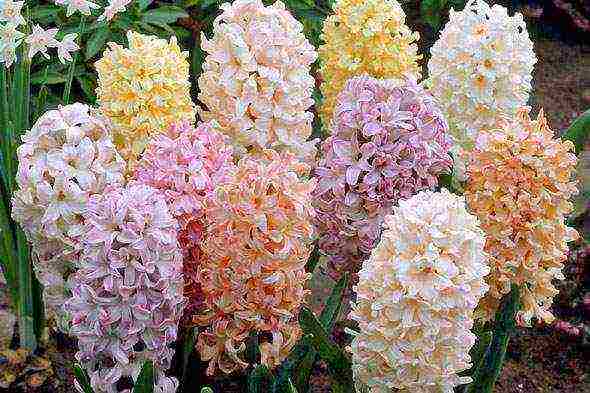
Before planting, it is recommended to soak the bulbs for half an hour in potassium permanganate (pale solution), in order to disinfect. The treated planting material should be planted, observing the distance between the plants 10 - 15 cm. The depth of the planting pits is 10 - 20 cm. The distance between the rows is recommended 20 cm. The pits should be filled with a layer of river sand approximately 5 cm thick. Place the onions in it.Sprinkle sand on top again, and then fill the hole with soil. Before the cold weather begins, be sure to insulate the garden bed with any available materials (spruce branches, dry peat, sawdust, humus).
When hyacinths bloom
These are early spring flowers that delight gardeners during the same period as tulips. Various varieties with different flowering periods have been bred:
- In the middle of April until the middle of May days, early varieties of hyacinths bloom and smell fragrant. Most often they have blue flowers.
- A little later, varieties of medium flowering bloom. Their color is more varied (lilac, pink, red, white).
- The latest flowering time for hyacinths is orange and yellow.
An ancient legend has survived to this day about the handsome and stately young man Hyacinth, who was in friendship with a god named Apollo. During a sports event involving discus throwing, Apollo accidentally killed Hyacinth. In the place where the drops of his blood soaked into the ground, flowers grew. They began to be called by the name of the youth.
You can do forcing in greenhouses or at home and get flowering plants in January. Before forcing, the bulbs should be stored at a low temperature (no higher than 9 degrees) for several months. 10 - 12 weeks medium and early varieties need to be cooled, late varieties should be kept in a cold place for 14 - 16 weeks. After planting, they begin to bloom after about a month. When stored warm, hyacinths will bloom only by March.
How to plant and care for flowers
The bulb has a lifespan of several years. After the end of flowering, dried inflorescences must be removed. The bulb can be fed and watered until the leaves dry on their own. This will happen in the month of June. Then the bulbs are dug up. Large "children" can be separated, and very small ones left. For half a month, they should lie somewhere, preferably with high humidity and an air temperature of about 30 degrees. Further, it must be reduced and gradually brought to 17 degrees. It is recommended to store the bulbs at this temperature until the autumn planting in the soil.
The hyacinth needs frequent loosening of the soil in the garden. Careful weed control is necessary.

The water at the root should not stagnate, but it is better that the earth does not dry out either. It is especially necessary to monitor humidity in dry and hot weather. The earth should be saturated with water about 20 cm deep.
For the entire period of active growth and flowering, the plant should be fed 2 times. Both liquid and dry dressings are suitable. When applied to the ground, fertilizers are scattered over the surface of the earth and sealed with a hoe. If dissolved fertilizer is used, then water should be done first, and then top dressing.
It is good to feed plants with superphosphate and saltpeter when they just started to release sprouts, about 20 g of each fertilizer per square meter. The next top dressing is necessary at the moment the buds appear (15 g of potassium sulfate and 30 g of superphosphate). The last time the hyacinths need to be fed is when they finish blooming. Fertilizers are used the same as for the second feeding.
Did you like the article? Share with your friends!
Hyacinth (hyacinthus) is a bulbous perennial plant belonging to the Asparagus family. His homeland is Asia. About 30 varieties were previously included in the genus of hyacinths, but after the reorganization of the classifications, only 3 species remained. The plant reaches a height of no more than 30 cm. The peduncle is covered with small flowers, similar in shape to bells. About 30 flowers bloom on one stem, exuding a strong aroma. Hyacinths can be grown at home or in the garden, but they need to be cared for to bloom profusely.
1 Landing in open ground
Hyacinths are grown from seeds or bulbs. The first method is laborious and time consuming. This technique is used mainly by professional breeders engaged in the development of new varieties. It is much easier to grow hyacinths from bulbs.In the Leningrad region and the Moscow region, their planting in open ground must be carried out in early or mid-autumn. In the Urals and Siberia, it is recommended to plant them in early September. Planting later is undesirable, since the bulbs will not have time to take root before the onset of frost.
It is not recommended to plant flowers in the spring.
Before planting hyacinths in open ground, it is necessary to prepare the soil in the selected area. First you need to dig up the ground and add mineral fertilizer to it at the rate of 70 g of superphosphate, 15 g of magnesium sulfate and 30 g of potassium per 1 sq. m. Rotten humus should also be added to the soil at the rate of 10 kg per 1 square meter. m.
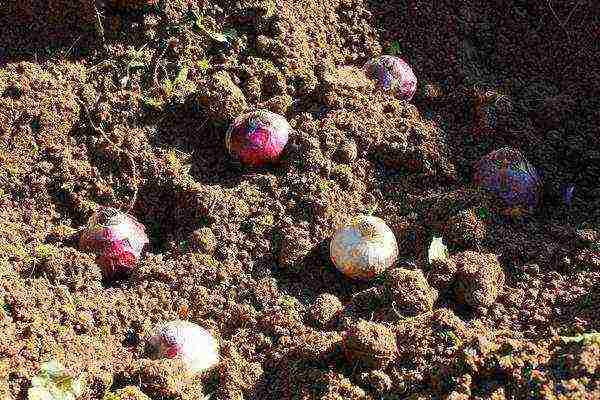
Planting hyacinths
For planting in the country in open ground, it is better to choose medium-sized bulbs. Before planting, it is recommended to hold them for 30 minutes in a fungicide solution. The distance between them should be at least 15 cm, and between the rows - about 20 cm. Small bulbs can be planted at a closer distance. Dry soil should be moistened.
Liatris: care and planting in open ground
2 Caring for flowers
These ornamental plants require moderate watering in dry weather. Waterlogging of the soil leads to rotting of the plant and its death.
Remove weeds and loosen the soil from time to time as needed.
Timely fertilization is equally important. You need to feed the flowers at least three times. Before doing this, it is recommended to moisten the ground. Nutrients are added according to the following scheme:
- 1. The first feeding is carried out at the beginning of hyacinth growth. It is recommended to use a mixture containing superphosphate and nitrate as a fertilizer.
- 2. The second is carried out during the budding period. In this case, a mixture of potassium sulfate and superphosphate is used.
- 3. The third is carried out after the end of flowering. In this case, a fertilizer with a high nitrogen content is suitable.
After flowering, the hyacinth begins a dormant period that lasts about 2 to 3 months. At this time, it is advisable to feed the flower once every 3 weeks. As soon as the dormant period comes to an end, the yellowed shoots should be cut off, and the bulbs should be pulled out of the ground, dried and set aside until autumn.
Often, hyacinth develops bacterial rot. The characteristic signs of the disease are spots on the peduncle and foliage, as well as significant growth retardation. Injured plants must be dug up and burned, and the planting hole must be treated with bleach.
Sometimes hyacinth also has fungal diseases. Their development is signaled by a plaque covering the leaves and peduncles of the plant. You can get rid of the disease by spraying with a product containing copper.
The hyacinths are attacked by flower flies, whose larvae eat the bottoms of the bulbs. The drug "Tabazol" will help to destroy parasites.
3 The process of forcing at home
Distillation refers to a technology that accelerates plant growth. Since the flowering period of hyacinths is quite short, it is advisable to resort to this technique at home. In order to get flowers in March, you need to dig up the bulbs in the summer. Then they need to be stored for 2 months in a dry place at a temperature not lower than +25 degrees. At the beginning of autumn, it is recommended to transfer the bulbs to the refrigerator by packing them in a cloth bag.
Many growers practice growing hyacinths by March 8th. To do this, they need to be planted at the end of autumn. Plant the bulbs correctly in non-acidic and nutritious soil, a low capacity will do. The soil mixture should consist of leafy earth and river sand. Several bulbs can be planted in one container at once, but they should not touch each other. The soil must be slightly moistened and the bulbs must be sprinkled on top with a small amount of loose earth. At the same time, the crown must remain open.Then, for a couple of months of planting, you need to remove it in a dark place where the temperature will be within + 4 ... + 6 degrees, for example, a refrigerator. Shelter is not required.
The first leaves will appear in about 10 weeks. As soon as they reach at least 4 cm in length, the containers with the bulbs must be rearranged to a cool place and protected from direct sunlight, covered with a paper cap. The optimal temperature regime during this period is +13 degrees. It is necessary to regularly moisten the soil.
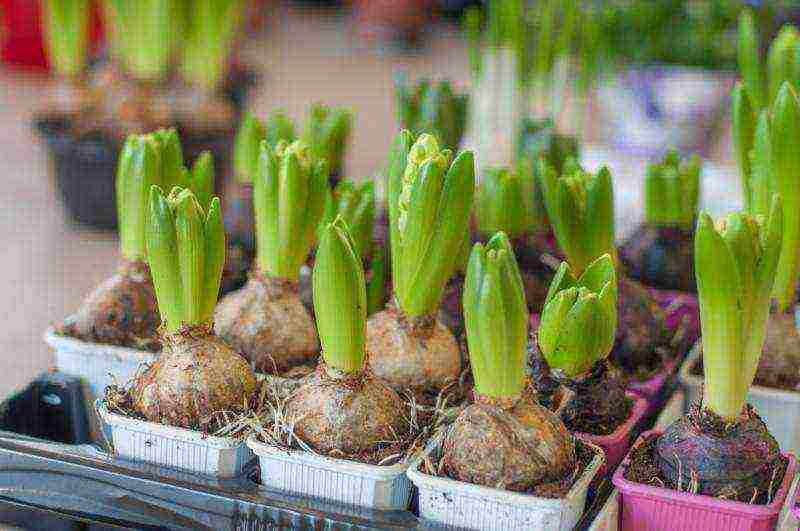
Distillation
As soon as the leaves open and the peduncle appears, the container will need to be rearranged in a well-lit place. If you wish, you can transplant the bulbs into larger pots.
For long-term flowering, it is necessary to protect hyacinths from drafts and exposure to direct sunlight. The pots should be removed away from various heaters and the room temperature should be kept at least +20 degrees.
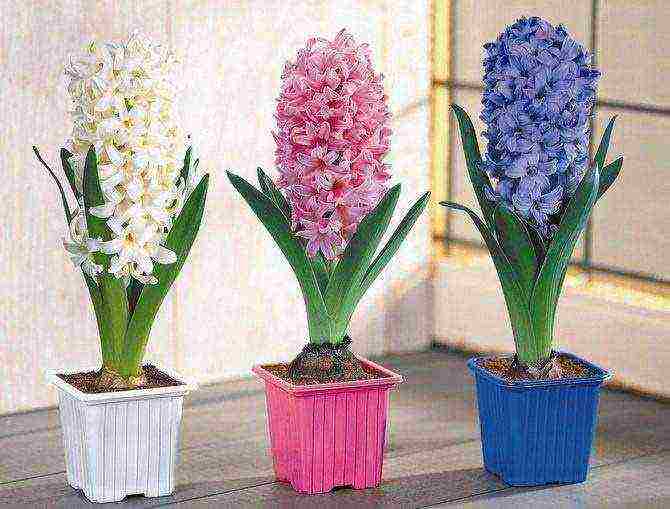
Published: 01 May 2013
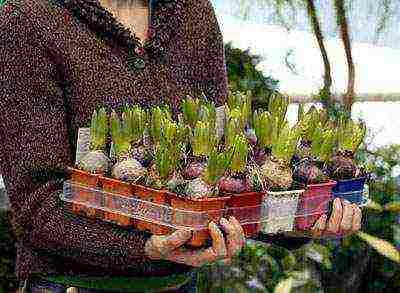 For the middle lane, this means, first of all, to bring the conditions of keeping bulbs in the dormant period closer to the conditions of a distant homeland, that is, to increase its duration and increase the temperature. By performing a number of techniques, the duration of the rest period can be increased from 3 to almost 5 months. This is achieved by adjusting flowering and digging to an earlier date, keeping the bulbs dug out at a certain temperature regime, late planting, shelter and insulation.
For the middle lane, this means, first of all, to bring the conditions of keeping bulbs in the dormant period closer to the conditions of a distant homeland, that is, to increase its duration and increase the temperature. By performing a number of techniques, the duration of the rest period can be increased from 3 to almost 5 months. This is achieved by adjusting flowering and digging to an earlier date, keeping the bulbs dug out at a certain temperature regime, late planting, shelter and insulation.
Planting site and soil
Place for hyacinths should be well lit and protected from strong winds. Some growers recommend planting them, like other bulbs, next to shrubs and trees. This advice is hardly good. Yes, there is enough sun in the spring, but the roots of trees and shrubs absorb nutrients from the soil to the detriment of hyacinths.
Plot; preferable flat, preferably with a slight slope, providing water flow during spring thaw of snow and during heavy rains. Prolonged flooding leads to massive diseases and death of bulbs. Groundwater should lie no closer than 50-60 cm. At a high level, drainage is made or soil is poured in order to raise the flower garden. By the way, hyacinths are very demanding on the soil. The best ones for them are light, sandy, rich in humus, with high water and air permeability, neutral or slightly alkaline, with a pH of at least 6.5. The depth of the fertile layer should be at least 40 cm.
Old gardening guidelines recommend planting on loose garden soil fertilized with rotted manure, or in an artificial mixture of clay-turf soil, rotted manure, river sand and leaf humus in a ratio of 2: 2: 1: 1.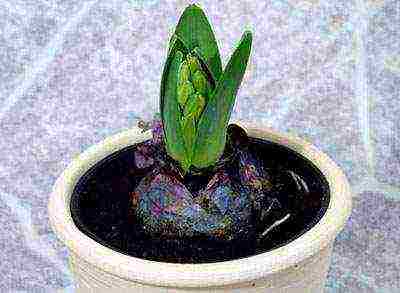 Too heavy clayey or infertile sandy soils need significant improvement; fresh manure is not applied due to the possibility of infection of the bulbs with rot; a good organic additive is river or lake silt, which is quite capable of replacing rotted manure or leafy soil.
Too heavy clayey or infertile sandy soils need significant improvement; fresh manure is not applied due to the possibility of infection of the bulbs with rot; a good organic additive is river or lake silt, which is quite capable of replacing rotted manure or leafy soil.
How to feed properly?
The main part of mineral fertilizers (phosphorus and potash) should be applied in the fall when planting. It is good to fill the soil with wood ash, preferably from deciduous trees. With the beginning of spring, nitrogen fertilizers are mainly applied (urea, ammonium sulfate, ammonium and sodium nitrate).
Average rates (in grams with the active substance per season per 1 sq. M) are N: R: K = 10:15:15. Chlorine fertilizers tend to be avoided.
Phosphorus is absorbed slowly, and therefore it accumulates in old cultivated soils, which are annually fertilized with mineral fertilizers. In such areas, it is either not applied at all or the dose is reduced.
Which bulb to choose?
The maximum size of adult bulbs is 4 to 6 cm, depending on the cultivar. Terry and yellow are usually smaller.
The bulbs must be firm, with a smooth surface, without mechanical damage and signs of disease, with a pronounced neck and shoulders. An important indicator of their quality is the ratio of the bottom diameter to the diameter of the bulb itself.If it is 1: 1.6 or more, everything is in order. In old and poorly grown bulbs, the bottom diameter in relation to the bulb diameter is less than 1: 1.6.
It is better to plant at a later date.
Best time planting hyacinths in the middle lane, October -1-15, so that the bulbs take root before the soil freezes in the second half or end of November.
Many people believe that it is all about a suitable soil temperature of 5-9 °, which promotes regrowth of roots. And early planting in warm soil with a temperature of more than 10 °, they say, worsens flowering, although most often it is the result of incomplete formation of inflorescences due to a dormant period interrupted too early. It is for its extension that the bulbs are planted at a later date (and not in September, like other bulbs).
However, hyacinths can be planted until the first half of November. But then the place should be insulated in advance with leaves or other material from those that are at hand, and protected with a film from rain and snow. And after planting, re-lay the insulation.
Landing in ridges is the most comfortable
It is convenient to plant single bulbs with a scoop, they dig a hole with a diameter of 10 cm and a depth of at least 25-30 cm.Then, to a depth of 15 cm, it is covered with a nutrient mixture with fertilizers, a layer of sand on top, and an onion is already placed on it. Carefully fill the well so that the bulb does not overturn, fill it to the top with light fertile soil.
If there are a lot of hyacinths, they are planted on ridges 15-20 cm high to protect the bulbs from melt water. In the spring, the ridges quickly warm up, they have good aeration of the upper layer. In addition, it is easy to install a film cover on the ridges.
They are planted in rows at a distance of 20-25 cm, at least 3 bulb diameters are left between adjacent bulbs in a row (for adult bulbs, 12-15 cm).
Planting depth is 4-5 times the height of the bulb (15 cm from the bottom for large bulbs). In an area with a low groundwater level, a deeper planting (by 25 cm) is also possible to protect against freezing. But then the peduncle will be lower.
The soil in a row is cultivated to a depth of 40-45 cm. The nutrient layer (below the bulb) is made up of ripe humus, garden soil and sand (on clay soils). Phosphorus-potassium fertilizers are added, in total 30-46 g of the active ingredient per 1 sq. M. It is helpful to add wood ash. The bulbs are placed on a 1-2 cm layer of sand and covered with light soil without fertilizers.
It is even more effective to completely remove the soil to a depth of 40-45 cm, lay a prepared fertile layer of 20-25 cm, compact it, pour 1-2 cm of sand and spread the bulbs on it. Labels are installed and then covered with soil without fertilizer (you can also take it out if it is light enough).
Do not be too lazy to cover for the winter
To protect the bulbs from severe freezing, the ridges are covered. This can be done immediately after planting and before the frosty days begin. Dry leaves, small scraps of thin branches, straw, needles, rotted sawdust are used. They are laid in a layer of 20-25 cm, going over the edge of the planting at the same distance.
Snow is also used for additional cover.
As it melts, the shelter is carefully removed, trying not to damage the fragile shoots, which by this time are showing up from the thawed ground.
From germination to digging - the time of "close communication"
After the spring waters disappear at the beginning of the regrowth of the shoots, the first liquid top dressing is done. It contains mainly nitrogen (N: P: K = 15: 5: 5 g of active ingredient per 1 sq. M).
The second is during the budding period (N: P: K = 5: 10: 5). If the soil during the autumn planting was well filled with organic and mineral fertilizers, then these dressings can be omitted.
The third top dressing immediately after flowering before the leaves lodge (P: K = 10:10).
Each feeding is accompanied by watering, water helps to deliver fertilizers to the roots in the lower feeding layer of the soil and rinses the upper one.
Drops of liquid should not fall on leaves and flowers. The top layer of the soil must be loosened. This is done very carefully so as not to damage fragile plants.
During examinations, plants with obvious signs of disease are destroyed. Impurities of a different kind are either removed or marked with labels and on planting plans, so that they can then be separated during digging.
The flowering time of hyacinths depends on the weather much more than tulips or daffodils. Hyacinths are more responsive to heat: their shoots always appear after thawing the soil and warming, later than tulips and even daffodils, but in warm weather hyacinths overtake them and bloom earlier.
I have been growing hyacinths in the Moscow region for 35 years. Over the years, the beginning of flowering fluctuated on a monthly basis (from April 15 to May 14).
For example, in 2000 the spring was delayed. Snow and water on the site melted only on April 5-7, and then it became very warm - in the afternoon about 20 °. The entire period from the emergence of shoots to the first flowers, which opened on April 17, in the early varieties was only 10-12 days (and this is without covering with a film).
The beginning of flowering of different varieties in one season differs by 10-12 days. The duration of flowering of an individual plant is 8-12 days, and under favorable conditions in some varieties up to 20 days.
Surprisingly, the timing depends on the color. Usually blue and blue varieties bloom early, yellow and orange - later. The leaves and stem continue to grow for some time after flowering, and then lodge and dry quickly.
Hyacinths bloom earlier, and bloom more amicably and longer if covered with a film. In addition, it is protection against frost and wind.


